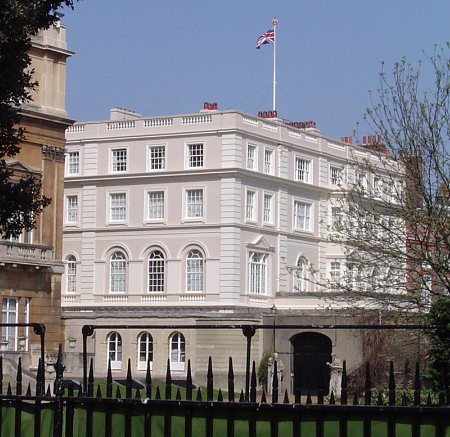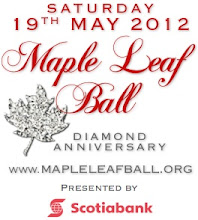
October 4, 2010
Not a tube strike, traffic, nor storm clouds could keep a sold-out group of CWC and Australian Women’s Club members and their friends from boarding the coach at 8:30 am for an eagerly anticipated trip to Highgrove. Our first stop, a mandatory shoppers’ destination, was Tetbury, once an ancient wool and yarn market located within the Cotswold district of Gloucestershire. Today it is renowned for its antique shops, elegant church spire and honey-coloured stones on the market square.
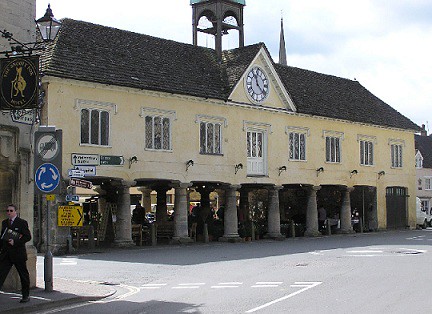
The Highgrove shop, situated at 10 Long Street occupies the major part of a period building thought to have been a brewery. It was just a shopping appetizer for us and a few minutes later, we reached Highgrove!
After a security and passport check, we were welcomed to the Estate by the scent of orchards and brilliant sunshine. Our 2 groups of 25, managed by Lolly Fullerton and Teresa Howe, were led by wonderfully knowledgeable volunteer guides who provided Royal anecdotes in addition to all aspects of the garden. Standing in front of the Orchard Room, a lime washed building of oak and stone designed by Charles Morris, a short history was provided.
Originally styled “High Grove”, it is the country home of The Prince, The Duchess of Cornwall and Princes William and Harry. It is also the location of the Home farm of the Duchy of Cornwall, well known for its organic foods and gardening. Built between 1796 and 1798 but due to 2 fires over the years, the buildings were restored with local Cotswolds Stones and other saved and recycled pieces. The Duchy of Cornwall acquired Highgrove House from the MP Maurice Macmillan, son of former Tory Prime Minister Harold Macmillan in 1980. It was indeed a blank canvass of 15 acres where The Prince has devoted much energy transforming the neglected grounds into some of the most innovative gardens existing today. Everything at Highgrove embodies the Prince’s environmental philosophy - that it is better to work with Nature than against it.
And you may wonder… What can one see in a garden in the autumn? Late season perennials such as asters, rudbeckias and sedums, add their strength in colour, as do the ripening apples and pears. And more…
After a security and passport check, we were welcomed to the Estate by the scent of orchards and brilliant sunshine. Our 2 groups of 25, managed by Lolly Fullerton and Teresa Howe, were led by wonderfully knowledgeable volunteer guides who provided Royal anecdotes in addition to all aspects of the garden. Standing in front of the Orchard Room, a lime washed building of oak and stone designed by Charles Morris, a short history was provided.
Originally styled “High Grove”, it is the country home of The Prince, The Duchess of Cornwall and Princes William and Harry. It is also the location of the Home farm of the Duchy of Cornwall, well known for its organic foods and gardening. Built between 1796 and 1798 but due to 2 fires over the years, the buildings were restored with local Cotswolds Stones and other saved and recycled pieces. The Duchy of Cornwall acquired Highgrove House from the MP Maurice Macmillan, son of former Tory Prime Minister Harold Macmillan in 1980. It was indeed a blank canvass of 15 acres where The Prince has devoted much energy transforming the neglected grounds into some of the most innovative gardens existing today. Everything at Highgrove embodies the Prince’s environmental philosophy - that it is better to work with Nature than against it.
And you may wonder… What can one see in a garden in the autumn? Late season perennials such as asters, rudbeckias and sedums, add their strength in colour, as do the ripening apples and pears. And more…
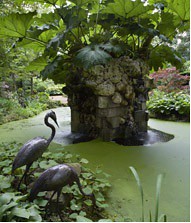
Our guide explained the interlinking of various themes and gardens, each with its own character and purpose. In the Thyme Walk, a lime avenue started with a bronze of a Borghese Gladiator and ended with a dovecote, a gift from the Sultan of Oman. Weaving through the magical woodland garden full of hostas – one of the Prince’s favourite plants, we glimpsed “Hollyrood House” a Tree house where the young Princes played as children. At the southern edge, the “Wall of Gifts”, a series of quirky architectural pieces from University students, was intriguing. We smiled at the luscious green Fern Pyramid that the Prince received for his 50th birthday and the mischievous Leprechauns given by a white witch from Ireland. We learned that the Prince loves moss, ferns and hostas, and birds. There are some 67 birdhouses for natural pest control.
Then there is the Azalea Walk, a special place adorned with busts of people The Prince admires – poets, scholars, environmental campaigners and composers. In contrast, to the left is a touching memorial to Tigga, the Prince’s much-loved Jack Russell Terrier, who rolled about in these gardens.
A contemplative arboretum featuring a stunning bronze titled “ The daughters of Odessa: Martyrs of Modernism, is dedicated to oppressed people of the world and situated in the healing garden dedicated to Queen Elizabeth the Queen Mother. How appropriate as The Prince learned so much about gardening from his grandmother. Further there is a sanctuary, a sundial garden and later we come upon the Highgrove Terraces and Cottage Gardens, full of memories and gifts – a catapa tree, a 50th birthday present to the Prince from Sir Elton John, a gateway of Indian doors from Jodhpur and a circular stone seat made by masons from Hereford Cathedral. Last we marvel at the lavish Carpet Garden, resembling a Turkish carpet, which was exhibited at the 2001 Chelsea Flower Show winning a Silver Medal. One is immediately transported to a Moroccan riad here, surrounded by olive trees, fountains, cork oaks, cypresses and vines.
Then there is the Azalea Walk, a special place adorned with busts of people The Prince admires – poets, scholars, environmental campaigners and composers. In contrast, to the left is a touching memorial to Tigga, the Prince’s much-loved Jack Russell Terrier, who rolled about in these gardens.
A contemplative arboretum featuring a stunning bronze titled “ The daughters of Odessa: Martyrs of Modernism, is dedicated to oppressed people of the world and situated in the healing garden dedicated to Queen Elizabeth the Queen Mother. How appropriate as The Prince learned so much about gardening from his grandmother. Further there is a sanctuary, a sundial garden and later we come upon the Highgrove Terraces and Cottage Gardens, full of memories and gifts – a catapa tree, a 50th birthday present to the Prince from Sir Elton John, a gateway of Indian doors from Jodhpur and a circular stone seat made by masons from Hereford Cathedral. Last we marvel at the lavish Carpet Garden, resembling a Turkish carpet, which was exhibited at the 2001 Chelsea Flower Show winning a Silver Medal. One is immediately transported to a Moroccan riad here, surrounded by olive trees, fountains, cork oaks, cypresses and vines.
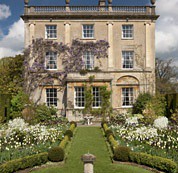
It seems that no CWC outing is quite complete without a Canadian connection. We were fortunate to meet Head Gardener Debs Goodenough who was busy planting bulbs. Some 30,000 bulbs are planted yearly using only natural fertilizers and mulch. Mrs.Goodenough was raised on a farm in Alberta and trained in horticulture in Canada. Later while working at Kew Gardens; she met her future husband and became Head Gardener at Osborne House, and managed other historic landscapes over a twelve-year period. In 2008, she was appointed to her present position. She smiled and told us that The Prince does get his hands dirty and is very involved in all aspects of the garden.
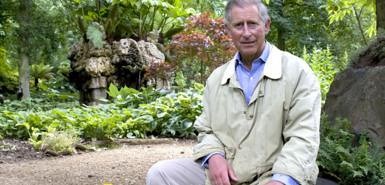
After our 2 hour walk though 2 miles of garden, many of us relaxed over tea and cake in the Orchard Room, while others perused the beautiful gifts in the adjoining shop.
On the trip back to London, Teresa, Lolly and Flora Tan uncorked a wine and cheese party complete with games for “royal prizes”. Yes we had traffic and a long coach ride but there was new respect for the Prince’s pioneering work in organic gardening and a lovely day of delightful memories.
All profits from the shops go to The Prince’s Charities. To find out more, visit the web site at http://www.princescharities.org.
Submitted by CWC Past President Teresa Howe. Teresa wishes to thank Lolly Fullerton for all their her help and especially for flying in from Canada for this event.
On the trip back to London, Teresa, Lolly and Flora Tan uncorked a wine and cheese party complete with games for “royal prizes”. Yes we had traffic and a long coach ride but there was new respect for the Prince’s pioneering work in organic gardening and a lovely day of delightful memories.
All profits from the shops go to The Prince’s Charities. To find out more, visit the web site at http://www.princescharities.org.
Submitted by CWC Past President Teresa Howe. Teresa wishes to thank Lolly Fullerton for all their her help and especially for flying in from Canada for this event.
